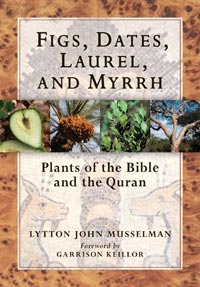When war zones look like home
Posted on | January 29, 2013 | No Comments

War in my lifetime has taken place abroad. Since becoming a California gardener in the late 1990s, however, the battlegrounds look a lot less foreign. It’s the plants. In Iraq, the date palms shaken by relentless bombing are the same species farmed in Coachella and then dug up from there and transplanted to line the avenues of Los Angeles and Las Vegas. Date palms are cited ten times in the Quran, according to Figs, Dates, Laurel and Myrrh: Plants of the Bible and the Quran. “In both holy books, palm trees are likened to humans,” observes its author, botanist Lytton John Musselman. Among his examples:
“Thy stature is like to a palm tree” (Song of Solomon 7:7, KJV)
“Which snatched away men as though they were palm trees pulled out by the roots.” (Sura 54:20, Ali)
There is nothing alien to most Californians about olive groves either, until one reads news reports of the destruction of old groves on the West Bank. Here in the Western US it is not Israeli settlers driving the bulldozers to unseat Palestinians, but Ventura County and Central Valley developers moving to convert farms to houses. From Musselman’s chapter on the olive:
“Let man reflect on the food he eats: how We pour down the rain in torrents and cleave the earth asunder; how We bring forth the corn, the grapes and the fresh vegetation; the olive and the palm, the thickets, the fruit-trees and the green pasture, for you and for your cattle to delight in” (Sura 80:24-32, Dawood; referred to similarly in Deuteronomy 8:8)
Recently, as if seeking relief from the horror of the Syrian civil war, I’ve found myself looking for Aleppo pines in news stills and footage. According to Musselman, this ancient Mediterranean pine isn’t named in the Bible, but Pinus halepensis may have been the source of resin used to seal Moses’s basket:
“But when she could hide him no longer, she got a papyrus basket for him and coated it with tar and pitch. Then she placed the child in it and put it among the reeds along the bank of the Nile.” (Exodus 2:3, NIV)
Today Aleppo pine forests are found in Israel and Jordan, Musselman notes. To these cornerstones of the cradle of civilization, I would add the Southern Californian forecourts of Orchard Supply Hardware outlets every December, where the Middle Eastern conifers are a favorite choice for potted “living Christmas trees.”
If I were religious and this were a homily, this post might close with some sort of moral. But I’m not, this is not. The solace and pearls are to be found in Musselman’s beautiful and erudite little book.
Tags: chance of rain > Figs Dates Laurel and Myrrh > Lytton John Musselman > Timber Press
Comments
Leave a Reply


